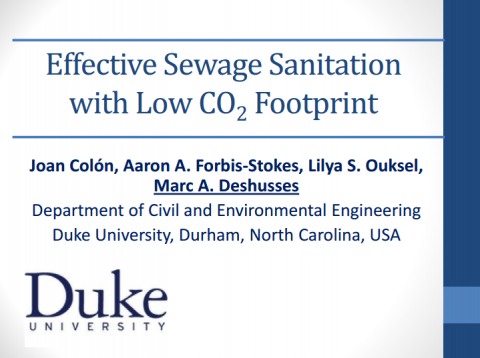Effective sewage sanitation with low CO2 footprint - Various documents on results from research grant
Deshusses, M. (2013)

Published in: 2013
Publisher:
Duke University, Durham, North Carolina, USA
Author:
Deshusses, M.
Uploaded by:
SuSanA secretariat
Partner profile:
common upload
5229 Views
140 Downloads
Content - Summary
This library entry contains background documents for a grant that Marc Deshusses is leading and which is funded by the Bill and Melinda Gates Foundation.
Further information and a discussion is available on the SuSanA discussion Forum, see link below.
Short description of the project:
The overall objective of our project is to develop and demonstrate the proof of concept a novel self-contained and energy neutral sanitation technology that relies on anaerobic digestion of the wastes to generate biogas and utilization of the biogas thus produced to heat-sterilize the treated effluent. The system utilizes simple and reliable equipment so that it does not require a skilled operator or any special maintenance regime.
Goal: Provide proof of concept of anaerobic digestion coupled with heat sterilization for a self-sanitizing system for developing communities
Activities and objectives
The project has been divided in two main parts:
a) The anaerobic reactor (lab scale): design and performance
b) The heat sterilization system (full-scale or near full-scale): design, construction and proof of concept to heat-sterilize the treated sewage effluent
The main goal of the lab anaerobic reactor is to prove the suitability of a mixture of feces and urine to serve as a substrate for the anaerobic process focused mainly in the yield and rate of biogas production. The concern is mainly to achieve usual biogas yields and obtain suitable rates of biogas production.
Regarding the heat sterilization system, the challenge is to design a simple and low-cost system with virtually no moving parts, that can effectively deployed, e.g., as a replacement of pit latrines.
Research or implementation partners: Chepkoilel University, Eldoret, Kenya
Further authors:
Deshusses, M., Colon, J., Forbis-Stokes, A.
+++++++++++
Documents available for download below:
1 - Effective sewage sanitation with low CO2 footprint (Paper at FSM2 Conference in Durban, South Africa, Oct. 2012)
2 - Effective sewage sanitation with low CO2 footprint (Presentation at FSM2 Conference in Durban, South Africa, Oct. 2012)
3 - Presentation on anaerobic digestion-pasteurization latrine at FSM3 Conference in Hanoi, Vietnam, Jan. 2015 (by Aaron A. Forbis-Stokes , Lilya Ouksel, Patrick O’Meara, Gelas M. Simiyu, Marc A. Deshusses)
4 - Journal paper: Anaerobic digestion of undiluted simulant human excreta for sanitation
and energy recovery in less-developed countries (December 2015)
5 - Poster at the University of North Carolina's Water & Health Conference on October 28, 2015 titled 'Anaerobic Digestion Pasteurization Latrine - Two Year Study of An Innovative Sewage Treatment System in Eldoret, Kenya.'
Bibliographic information
Deshusses, M. (2013). Effective sewage sanitation with low CO2 footprint - Various documents on results from research grant. Duke University, Durham, North Carolina, USA
Filter tags
Biogas systems English Fundamental research and engineering North America Sub-Saharan Africa















